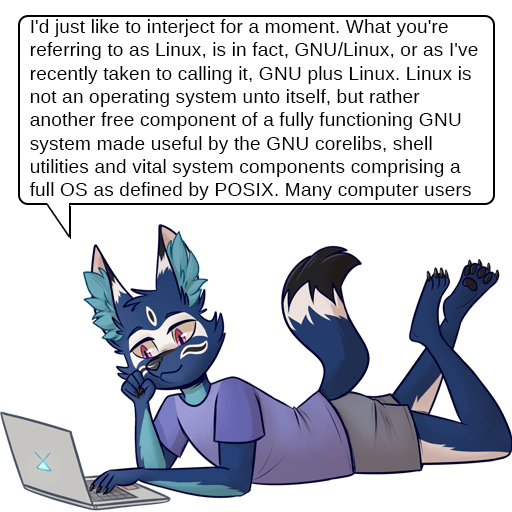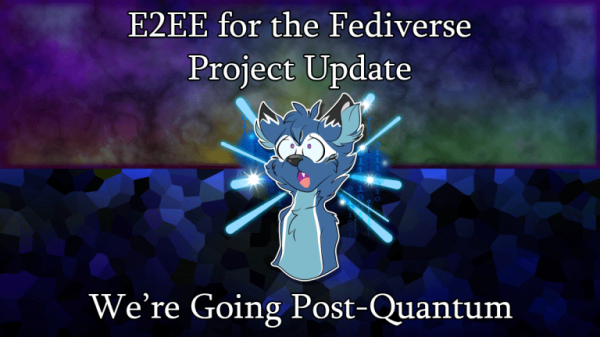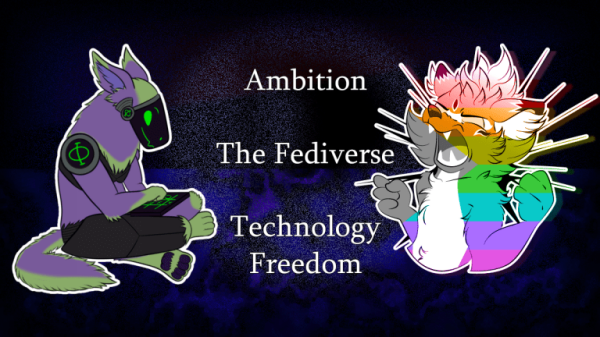Search
Items tagged with: TechFreedom
If you’re new to reading this blog, you might not already be aware of my efforts to develop end-to-end encryption for ActivityPub-based software. It’s worth being aware of before you continue to read this blog post.
To be very, very clear, this is work I’m doing independent of the W3C or any other standards organization and/or funding source (and they have their own ideas about how to approach it).Really, I’m doing my own thing and releasing my designs under a public domain-equivalent license so anyone (including the W3C grant awardees) can pick it up and use it, if they see fit.
But the work I’m doing has no official standing and is not representative of anyone (except maybe a lot of other furries interested in technology). They have, emphatically, never endorsed anything I’m doing. I have not talked with any of them about my ideas, nor has my name come up in any of their meeting notes.
My background is in applied cryptography and software security assessments, so I have strong opinions about how such software should be developed.
I’m being very up-front about this because I don’t want anyone to mistake my ideas for anything “official”.
Why spend your time on that?
My end goal is pretty straightforward.
Before Musk took it over, Twitter was wonderful for queer people. I’ve even heard it described as the most successful dating platform for the LGBTQIA+ community.
These days, it’s full of Nazis and people who think the ideal version of “free speech” means not being allowed to say the word “cisgender.” But I repeat myself.
The typical threat model for Twitter was: You have to trust the person you’re talking with, and the Twitter corporation, to keep your conversations (or nudes, if we’re being frank about it) private.
With the Fediverse, things are a little more complicated. Instance operators also have access to the plaintext versions of any Direct Messages between you and other participants.
And maybe you trust your instance operator… but do you trust your friends’? And do they trust yours?
If implemented securely, end-to-end encryption saves you from having to care about this injection of additional threat actors to consider.
If not implemented securely, it’s little more than security theater and should be ridiculed loudly.
So it’s natural and obvious for a person with my particular interests and skills to want to solve this problem.
Technological Decisions
When I started this project, I separated the end goal into 4 separate components:
- Client-side secret key management.
- Federated public-key infrastructure.
- Shared key agreement for group messaging.
- The actual bulk encryption techniques.
A lot of hobbyist projects over-index on the fourth component, rather than the actual hard problems. This is why so many doomed projects start with PGP, or implement weird “cipher cascades” to hedge against AES getting broken.
In reality, every component matters for the security of the whole system, but the bulk encryption is boring. It’s the well-tread path of any cryptosystem. The significantly harder parts are key management.
Political Decisions
Let’s not mince words: How you implement key management is inherently a political decision.
If that sounds counter-intuitive, meditate on this bit of wisdom for a while:
Repeat after me: all technical problems of sufficient scope or impact are actually political problems first.
Many projects, when confronted with the complexity of key management, are perfectly happy with “just write private keys to disk” or “put blind trust in AWS KMS.”
Or, more directly: “YOLO.”
With my Fediverse E2EE project, I wanted to minimize the amount of trust you have to place in others. (Especially, minimize the trust needed in Soatok!)
How Decisions Flow
Client-side secrets are the most visible area of risk to end users. Backing up and managing their own credentials, recovering from failure modes, the Mud Puddle test, etc.
Once each participant has secret keys managed (1), they can provide public keys to each other.
Public-key infrastructure (2) is how you decide trust relationships between parties. We’re operating in a federated environment, and want to minimize the amount of unchecked “authority” anyone has, so that complicates matters. But, if it wasn’t challenging, it would already be solved.
Once you’ve figured out a trust mechanism to tie a public key to an identity, you can try to agree on a shared symmetric key securely, even over an untrusted channel.
Key agreement for group messaging (3) is how you decide which shared key to use, and when, and who has access to this key and for how long.
And from there, you can actually encrypt shit (4).
It doesn’t really matter how much you boil the ocean on mitigating hypothetical weaknesses in AES if an adversary can muck with your key management.
Thus, it should hopefully be reasonable to divide the work up in this fashion.
But there is a fifth component; one that I am not qualified to comment on:
User experience.
The final deliverable for my participation in this project will be software libraries (and any necessary patches to server software) to facilitate secure end-to-end encryption between Fediverse users.
As for what that experience looks like? How it’s presented visually? What accessibility features are used, and how? How elements are organized and in what order they are displayed? Any quality-of-life design decisions that delight users and avoid dark patterns?
Yeah, sorry, I’m totally out of my depth here. That’s not my domain.
I will do my damnedest to not make security decisions that are inherently onerous towards making usable software.
(After all, security at the cost of usability comes at the cost of security.)
But I can’t promise that the experience will be totally seamless for everyone, all the time.
Lacking Ambition?
One of the things that’s been bothering me, as I work on out the finer details about this end-to-end encryption project, is that it seems to lack ambition.
Sure, I can talk your ear off for hours about the ins and outs of implementing end-to-end encryption securely, but we already have end-to-end encryption apps. So many private messengers.
How does “you can now have encrypted DMs in Mastodon” help people who can already use Signal or WhatsApp? Why should the people who aren’t computer nerds care about it at all?
What’s actually new or exciting about this work?
And, honestly, the best answer I can come up with is that it’s the first step.
Tech Freedom and You
Before the Big Data and cloud computing crazes took the technology industry by storm (or any of the messes that followed), most software was designed to work offline. That is, without Internet access.
With the growing ubiquity of Internet access (and mobile networks), the Overton window shifted towards always-on devices, edge computing, and no longer owning anything. Instead, consumers rent licenses to software that a third party can revoke on a whim.
The Free Software movement, for all of the very pronounced personality quirks associated with it today, foresaw this problem long before the modern Internet existed. Technologists, lawyers, and activists spent thousands of person-years of effort on trying to protect end users’ rights from greedy monopolies.

(I couldn’t not include this meme in this section.)
This isn’t a modern problem, by any stretch of the imagination.
Every year, our rights and digital freedoms are eroded by court decisions by corrupt judges, terrible legislature, and questionable leadership.
But the Electronic Frontier Foundation and its friends in other nations have been talking about this and fighting court battles since the 1990s.
Even if I somehow made some small innovation that benefited end users with allowing Fediverse users to message each other privately, that’s not really ambitious either.
From Sparks to Embers
As I was noodling over this, a friend of mine linked me to an article titled Rust Needs a Web Framework for Lazy Developers the other day.
It made me realize how much I miss the era when software was offline-first, even if it had online components. The past several years of Live Service Games has exhausted my tolerance more than anything else, but they’re not alone.
When I initially delineated my proposal into 4 components, my goal was to simplify the security analysis and make the threat models digestible.
But it occurred to me, recently, that by abstracting these components (especially the Federated Public Key Infrastructure design), a new era of cypherpunks and pirates could breathe new ambition into software projects that build atop the boring infrastructure I’m building.
Let’s Turn the Ambition Up To 11
Imagine peer-to-peer software that uses the Fediverse and/or onion routing technologies (similar to Tor) to establish peer-to-peer encrypted data tunnels between devices, with the Federated PKI as the source of truth for identity public keys so you always know you’re talking to the correct entity.
Now combine that with developer tools that make it easy for people to self-publish software (even if only through Tor Hidden Services), with an optional way to create a public portal (e.g., for a public-facing website).
You could even create a protocol for people with rack space and spare bandwidth to host said public portals, without biasing for a particular one.
This would allow technologists to build the tools for normal people to create an anti-corporate, decentralized network.
And you could do it without ever mentioning the word “blockchain” (though you may need to tolerate it if you want to prevent anti-porn groups like Exodus Cry from having any say in what we compute).
Finally, imagine that we build all of this in memory-safe languages.
Are you building this today?
In short: No, I’m not.
Ambitious ideas and cryptography should only intersect rarely. I’m focused on the cryptography.
Instead, I wanted to lay this rough sketch out there as a possibility that someone else–presumably more ambitious, charismatic, and/or resourceful–could easily pick up if they so choose.
More importantly, all of the hard parts of this would be solved problems by the time I finish with the end-to-end encryption project. (Most of them already exist, in fact!)
That’s what I meant above by “it’s the first step”.
Along the way to achieving my own goals, I’m building at least one useful building block. What the rest of the technology industry decides to do with it is up to the rest of us.
I can’t, and will not try, to do it alone.
There is a lot of potential for tech freedom that could benefit users beyond what they can get from the Fediverse today. I wanted to examine how some of these ideas could be useful for–
Rejected! What else you got?
Oh.
…
Okay, so y’know how a lot of video games (Undertale/Deltarune, Doki Doki Literature Club) try to make a highly immersive experience with many diegetic elements?
Let’s build an operating system, based on some flavor of Linux, that is in and of itself a game. People can write their own DLC by developing packages for that OS. The end deliverable will be a virtual machine, and in order to get it to work on Steam, we would install Docker or Kubernetes, but users will also be able to install it via VirtualBox.
Inevitably, someone will decide this OS is their new daily driver. Imagine the impact this would have on corporate IT the whole world over.
This is the worst idea in the history of bad ideas!
Oh, I can do worse. I can do so much worse.
I don’t know if I can top the various attempts to build a Message Authentication Code out of the insecure RC4 stream cipher, of course.
If you want ambition, you sacrifice wisdom.
If you want freedom, you sacrifice convenience.
If you want security, you sacrifice usability.
…
Or do you?
They Can’t All Be Winners
I have a lot of bad ideas, all the time. That’s the only reason I ever occasionally have moderately good ones.
My process of eliminating bad ideas is ruthless, and may cull some interesting or fun ones along the way. This is an unfortunate side-effect of being an effective security engineer.
I don’t actually think the ideas I’ve written above are that bad. I wrote them this way for comedic effect.
Rather, I’m just not actually sure they’re actually good, or worthwhile to invest time into.
Whether someone could build atop the work I’m doing to reclaim our Internet from the grip of massive technology corporations is, at best, difficult to classify.
I do not have the time, energy, or motivation to do the work already on my own plate and then explore these ideas fully.
Maybe someone reading this does?
If not, that’s cool. Ideas are allowed to just exist as idle curiosities. Not everything has to matter all the time.
The “ship a whole god damn OS as an indie
game” idea could be fun though.
https://soatok.blog/2024/10/12/ambition-the-fediverse-and-technology-freedom/
#endToEndEncryption #fediverse #FreeSoftware #OnlinePrivacy #Society #SoftwareFreedom #TechFreedom #Technology
In 2022, I wrote about my plan to build end-to-end encryption for the Fediverse. The goals were simple:
- Provide secure encryption of message content and media attachments between Fediverse users, as a new type of Direct Message which is encrypted between participants.
- Do not pretend to be a Signal competitor.
The primary concern at the time was “honest but curious” Fediverse instance admins who might snoop on another user’s private conversations.
After I finally was happy with the client-side secret key management piece, I had moved on to figure out how to exchange public keys. And that’s where things got complicated, and work stalled for 2 years.
Art: AJ
I wrote a series of blog posts on this complication, what I’m doing about it, and some other cool stuff in the draft specification.
- Towards Federated Key Transparency introduced the Public Key Directory project
- Federated Key Transparency Project Update talked about some of the trade-offs I made in this design
- Not supporting ECDSA at all, since FIPS 186-5 supports Ed25519
- Adding an account recovery feature, which power users can opt out of, that allows instance admins to help a user recover from losing all their keys
- Building a Key Transparency system that can tolerate GDPR Right To Be Forgotten takedown requests without invalidating history
- Introducing Alacrity to Federated Cryptography discussed how I plan to ensure that independent third-party clients stay up-to-date or lose the ability to decrypt messages
Recently, NIST published the new Federal Information Protection Standards documents for three post-quantum cryptography algorithms:
- FIPS-203 (ML-KEM, formerly known as CRYSTALS-Kyber),
- FIPS-204 (ML-DSA, formerly known as CRYSTALS-Dilithium)
- FIPS-205 (SLH-DSA, formerly known as SPHINCS+)
The race is now on to implement and begin migrating the Internet to use post-quantum KEMs. (Post-quantum signatures are less urgent.) If you’re curious why, this CloudFlare blog post explains the situation quite well.
Since I’m proposing a new protocol and implementation at the dawn of the era of post-quantum cryptography, I’ve decided to migrate the asymmetric primitives used in my proposals towards post-quantum algorithms where it makes sense to do so.
Art: AJ
The rest of this blog post is going to talk about technical specifics and the decisions I intend to make in both projects, as well as some other topics I’ve been thinking about related to this work.
Which Algorithms, Where?
I’ll discuss these choices in detail, but for the impatient:
- Public Key Directory
- Still just Ed25519 for now
- End-to-End Encryption
- KEMs: X-Wing (Hybrid X25519 and ML-KEM-768)
- Signatures: Still just Ed25519 for now
Virtually all other uses of cryptography is symmetric-key or keyless (i.e., hash functions), so this isn’t a significant change to the design I have in mind.
Post-Quantum Algorithm Selection Criteria
While I am personally skeptical if we will see a practical cryptography-relevant quantum computer in the next 30 years, due to various engineering challenges and a glacial pace of progress on solving them, post-quantum cryptography is still a damn good idea even if a quantum computer doesn’t emerge.Post-Quantum Cryptography comes in two flavors:
- Key Encapsulation Mechanisms (KEMs), which I wrote about previously.
- Digital Signature Algorithms (DSAs).
Originally, my proposals were going to use Elliptic Curve Diffie-Hellman (ECDH) in order to establish a symmetric key over an untrusted channel. Unfortunately, ECDH falls apart in the wake of a crypto-relevant quantum computer. ECDH is the component that will be replaced by post-quantum KEMs.
Additionally, my proposals make heavy use of Edwards Curve Digital Signatures (EdDSA) over the edwards25519 elliptic curve group (thus, Ed25519). This could be replaced with a post-quantum DSA (e.g., ML-DSA) and function just the same, albeit with bandwidth and/or performance trade-offs.
But isn’t post-quantum cryptography somewhat new?
Lattice-based cryptography has been around almost as long as elliptic curve cryptography. One of the first designs, NTRU, was developed in 1996.Meanwhile, ECDSA was published in 1992 by Dr. Scott Vanstone (although it was not made a standard until 1999). Lattice cryptography is pretty well-understood by experts.
However, before the post-quantum cryptography project, there hasn’t been a lot of incentive for attackers to study lattices (unless they wanted to muck with homomorphic encryption).
So, naturally, there is some risk of a cryptanalysis renaissance after the first post-quantum cryptography algorithms are widely deployed to the Internet.
However, this risk is mostly a concern for KEMs, due to the output of a KEM being the key used to encrypt sensitive data. Thus, when selecting KEMs for post-quantum security, I will choose a Hybrid construction.
Hybrid what?
We’re not talking folfs, sonny!Hybrid isn’t just a thing that furries do with their fursonas. It’s also a term that comes up a lot in cryptography.
Unfortunately, it comes up a little too much.
I made this dumb meme with imgflip
When I say we use Hybrid constructions, what I really mean is we use a post-quantum KEM and a classical KEM (such as HPKE‘s DHKEM), then combine them securely using a KDF.Post-quantum KEMs
For the post-quantum KEM, we only really have one choice: ML-KEM. But this choice is actually three choices: ML-KEM-512, ML-KEM-768, or ML-KEM-1024.The security margin on ML-KEM-512 is a little tight, so most cryptographers I’ve talked with recommend ML-KEM-768 instead.
Meanwhile, the NSA wants the US government to use ML-KEM-1024 for everything.
How will you hybridize your post-quantum KEM?
Originally, I was looking to use DHKEM with X25519, as part of the HPKE specification. After switching to post-quantum cryptography, I would need to combine it with ML-KEM-768 in such a way that the whole shebang is secure if either component is secure.But then, why reinvent the wheel here? X-Wing already does that, and has some nice binding properties that a naive combination might not.
So let’s use X-Wing for our KEM.
Notably, OpenMLS is already doing this in their next release.
Art: CMYKat
Post-quantum signatures
So our KEM choice seems pretty straightforward. What about post-quantum signatures?Do we even need post-quantum signatures?
Well, the situation here is not nearly as straightforward as KEMs.
For starters, NIST chose to standardize two post-quantum digital signature algorithms (with a third coming later this year). They are as follows:
- ML-DSA (formerly CRYSTALS-Dilithium), that comes in three flavors:
- ML-DSA-44
- ML-DSA-65
- ML-DSA-87
- SLH-DSA (formerly SPHINCS+), that comes in 24 flavors
- FN-DSA (formerly FALCON), that comes in two flavors but may be excruciating to implement in constant-time (this one isn’t standardized yet)
Since we’re working at the application layer, we’re less worried about a few kilobytes of bandwidth than the networking or X.509 folks are. Relatively speaking, we care about security first, performance second, and message size last.
After all, people ship Electron, React Native, and NextJS apps that load megabytes of JavaScript code to print, “hello world,” and no one bats an eye. A few kilobytes in this context is easily digestible for us.
(As I said, this isn’t true for all layers of the stack. WebPKI in particular feels a lot of pain with large public keys and/or signatures.)
Eliminating post-quantum signature candidates
Performance considerations would eliminate SLH-DSA, which is the most conservative choice. Even with the fastest parameter set (SLH-DSA-128f), this family of algorithms is about 550x slower than Ed25519. (If we prioritize bandwidth, it becomes 8000x slower.)
Adopted from CloudFlare’s blog post on post-quantum cryptography.
Between the other two, FN-DSA is a tempting option. Although it’s difficult to implement in constant-time, it offers smaller public key and signature sizes.
However, FN-DSA is not standardized yet, and it’s only known to be safe on specific hardware architectures. (It might be safe on others, but that’s not proven yet.)
In order to allow Fediverse users be secure on a wider range of hardware, this uncertainty would limit our choice of post-quantum signature algorithms to some flavor of ML-DSA–whether stand-alone or in a hybrid construction.
Unlike KEMs, hybrid signature constructions may be problematic in subtle ways that I don’t want to deal with. So if we were to do anything, we would probably choose a pure post-quantum signature algorithm.
Against the Early Adoption of Post-Quantum Signatures
There isn’t an immediate benefit to adopting a post-quantum signature algorithm, as David Adrian explains.The migration to post-quantum cryptography will be a long and difficult road, which is all the more reason to make sure we learn from past efforts, and take advantage of the fact the risk is not imminent. Specifically, we should avoid:
- Standardizing without real-world experimentation
- Standardizing solutions that match how things work currently, but have significant negative externalities (increased bandwidth usage and latency), instead of designing new things to mitigate the externalities
- Deploying algorithms pre-standardization in ways that can’t be easily rolled back
- Adding algorithms that are pre-standardization or have severe shortcomings to compliance frameworks
We are not in the middle of a post-quantum emergency, and nothing points to a surprise “Q-Day” within the next decade. We have time to do this right, and we have time for an iterative feedback loop between implementors, cryptographers, standards bodies, and policymakers.
The situation may change. It may become clear that quantum computers are coming in the next few years. If that happens, the risk calculus changes and we can try to shove post-quantum cryptography into our existing protocols as quickly as possible. Thankfully, that’s not where we are.
David Adrian, Lack of post-quantum security is not plaintext.
Furthermore, there isn’t currently any commitment from the Sigsum developers to adopt a post-quantum signature scheme in the immediate future. They hard-code Ed25519 for the current iteration of the specification.The verdict on digital signature algorithms?
Given all of the above, I’m going to opt to simply not adopt post-quantum signatures until a later date.Version 1 of our design will continue to use Ed25519 despite it not being secure after quantum computers emerge (“Q-Day”).
When the security industry begins to see warning signs of Q-Day being realistically within a decade, we will prioritize migrating to use post-quantum signature algorithms in a new version of our design.
Should something drastic happen that would force us to decide on a post-quantum algorithm today, we would choose ML-DSA-44. However, that’s unlikely for at least several years.
Remember, Store Now, Decrypt Later doesn’t really break signatures the way it would break public-key encryption.
Art: Harubaki
Miscellaneous Technical Matters
Okay, that’s enough about post-quantum for now. I worry that if I keep talking about key encapsulation, some of my regular readers will start a shitty garage band called My KEMical Romance before the end of the year.Let’s talk about some other technical topics related to end-to-end encryption for the Fediverse!
Federated MLS
MLS was implicitly designed with the idea of having one central service for passing messages around. This makes sense if you’re building a product like Signal, WhatsApp, or Facebook Messenger.It’s not so great for federated environments where your Delivery Service may be, in fact, more than one service (i.e., the Fediverse). An expired Internet Draft for Federated MLS talks about these challenges.
If we wanted to build atop MLS for group key agreement (like has been suggested before), we’d need to tackle this in a way that doesn’t cede control of MLS epochs to any server that gets compromised.
How to Make MLS Tolerate Federation
First, the Authentication Service component can be replaced by client-side protocols, where public keys are sourced from the Public Key Directory (PKD) services.That is to say, from the PKD, you can fetch a valid list of Ed25519 public keys for each participant in the group.
When a group is created, the creator’s Ed25519 public key is known. Everyone they invite, their software necessarily has to know their Ed25519 public key in order to invite them.
In order for a group action to be performed, it must be signed by one of the public keys enrolled into the group list. Additionally, some actions may be limited by permissions attached at the time of the invite (or elevated by a more privileged user; which necessitates another group action).
By requiring a valid signature from an existing group member, we remove the capability of the Fediverse instance that’s hosting the discussion group to meddle with it in any way (unless, for some reason, the server is somehow also a participant that was invited).
But therein lies the other change we need to make: In many cases, groups will span multiple Fediverse servers, so groups shouldn’t be dependent on a single instance.
Spreading The Load Across Instances
Put simply, we need a consensus algorithm to determine which instance hosts messages. We could look to Raft as a starting point, but whatever we land on should be fair, fault-tolerant, and deterministic to all participants who can agree on the same symmetric keying material at some point in time.To that end, I propose using an additional HKDF output from the Group Key Agreement protocol to select a “leader” for all instances involved in the group, weighted by the number of participants on each instance.
Then, every N messages (where N >= 1), a new leader is elected by the same deterministic protocol. This will be performed entirely client-side, and clients will choose N. I will refer to this as a sub-epoch, since it doesn’t coincide with a new MLS epoch.
Since the agreed-upon group key always ratchets forward when a group action occurs (i.e., whenever there’s a new epoch), getting another KDF output to elect the next leader is straightforward.
This isn’t a fully fleshed out idea. Building consensus protocols that can handle real-world operational issues is heavily specialized work and there’s a high risk of falling to the illusion of safety until it’s too late. I will probably need help with this component.
That said, we aren’t building an anonymity network, so the cost of getting a detail wrong isn’t measurable in blood.
We aren’t really concerned with Sybil attacks. Winning the election just means you’re responsible for being a dumb pipe for ciphertext. Client software should trust the instance software as little as possible.
We also probably don’t need to worry about availability too much. Since we’re building atop ActivityPub, when a server goes down, the other instances can hold encrypted messages in the outbox for the host instance to pick up when it’s back online.
If that’s not satisfactory, we could also select both a primary and secondary leader for each epoch (and sub-epoch), to have built-in fail-over when more than one instance is involved in a group conversation.
If messages aren’t being delivered for an unacceptable period of time, client software can forcefully initiate a new leader election by expiring the current MLS epoch (i.e. by rotating their own public key and sending the relevant bundle to all other participants).
Art: Kyume
Those are just some thoughts. I plan to talk it over with people who have more expertise in the relevant systems.
And, as with the rest of this project, I will write a formal specification for this feature before I write a single line of production code.
Abuse Reporting
I could’ve swore I talked about this already, but I can’t find it in any of my previous ramblings, so here’s a good place as any.The intent for end-to-end encryption is privacy, not secrecy.
What does this mean exactly? From the opening of Eric Hughes’ A Cypherpunk’s Manifesto:
Privacy is necessary for an open society in the electronic age. Privacy is not secrecy.A private matter is something one doesn’t want the whole world to know, but a secret matter is something one doesn’t want anybody to know.
Privacy is the power to selectively reveal oneself to the world.
Eric Hughes (with whitespace and emphasis added)
Unrelated: This is one reason why I use “secret key” when discussing asymmetric cryptography, rather than “private key”. It also lends towardsskandpkas abbreviations, whereas “private” and “public” both start with the letter P, which is annoying.With this distinction in mind, abuse reporting is not inherently incompatible with end-to-end encryption or any other privacy technology.
In fact, it’s impossible to create useful social technology without the ability for people to mitigate abuse.
So, content warning: This is going to necessarily discuss some gross topics, albeit not in any significant detail. If you’d rather not read about them at all, feel free to skip this section.
Art: CMYKat
When thinking about the sorts of problems that call for an abuse reporting mechanism, you really need to consider the most extreme cases, such as someone joining group chats to spam unsuspecting users with unsolicited child sexual abuse material (CSAM), flashing imagery designed to trigger seizures, or graphic depictions of violence.
That’s gross and unfortunate, but the reality of the Internet.
However, end-to-end encryption also needs to prioritize privacy over appeasing lazy cops who would rather everyone’s devices include a mandatory little cop that watches all your conversations and snitches on you if you do anything that might be illegal, or against the interest of your government and/or corporate masters. You know the type of cop. They find privacy and encryption to be rather inconvenient. After all, why bother doing their jobs (i.e., actual detective work) when you can just criminalize end-to-end encryption and use dragnet surveillance instead?
Whatever we do, we will need to strike a balance that protects users’ privacy, without any backdoors or privileged access for lazy cops, with community safety.
Thus, the following mechanisms must be in place:
- Groups must have the concept of an “admin” role, who can delete messages on behalf of all users and remove users from the group. (Signal currently doesn’t have this.)
- Users must be able to delete messages on their own device and block users that send abusive content. (The Fediverse already has this sort of mechanism, so we don’t need to be inventive here.)
- Users should have the ability to report individual messages to the instance moderators.
I’m going to focus on item 3, because that’s where the technically and legally thorny issues arise.
Keep in mind, this is just a core-dump of thoughts about this topic, and I’m not committing to anything right now.
Technical Issues With Abuse Reporting
First, the end-to-end encryption must be immune to Invisible Salamanders attacks. If it’s not, go back to the drawing board.Every instance will need to have a moderator account, who can receive abuse reports from users. This can be a shared account for moderators or a list of moderators maintained by the server.
When an abuse report is sent to the moderation team, what needs to happen is that the encryption keys for those specific messages are re-wrapped and sent to the moderators.
So long as you’re using a forward-secure ratcheting protocol, this doesn’t imply access to the encryption keys for other messages, so the information disclosed is limited to the messages that a participant in the group consents to disclosing. This preserves privacy for the rest of the group chat.
When receiving a message, moderators should not only be able to see the reported message’s contents (in the order that they were sent), but also how many messages were omitted in the transcript, to prevent a type of attack I colloquially refer to as “trolling through omission”. This old meme illustrates the concept nicely:
Trolling through omission.
And this all seems pretty straightforward, right? Let users protect themselves and report abuse in such a way that doesn’t invalidate the privacy of unrelated messages or give unfettered access to the group chats. “Did Captain Obvious write this section?”But things aren’t so clean when you consider the legal ramifications.
Potential Legal Issues With Abuse Reporting
Suppose Alice, Bob, and Troy start an encrypted group conversation. Alice is the group admin and delete messages or boot people from the chat.One day, Troy decides to send illegal imagery (e.g., CSAM) to the group chat.
Bob immediately, disgusted, reports it to his instance moderator (Dave) as well as Troy’s instance moderator (Evelyn). Alice then deletes the messages for her and Bob and kicks Troy from the chat.
Here’s where the legal questions come in.
If Dave and Evelyn are able to confirm that Troy did send CSAM to Alice and Bob, did Bob’s act of reporting the material to them count as an act of distribution (i.e., to Dave and/or Evelyn, who would not be able to decrypt the media otherwise)?
If they aren’t able to confirm the reports, does Alice’s erasure count as destruction of evidence (i.e., because they cannot be forwarded to law enforcement)?
Are Bob and Alice legally culpable for possession? What about Dave and Evelyn, whose servers are hosting the (albeit encrypted) material?
It’s not abundantly clear how the law will intersect with technology here, nor what specific technical mechanisms would need to be in place to protect Alice, Bob, Dave, and Evelyn from a particularly malicious user like Troy.
Obviously, I am not a lawyer. I have an understanding with my lawyer friends that I will not try to interpret law or write my own contracts if they don’t roll their own crypto.
That said, I do have some vague ideas for mitigating the risk.
Ideas For Risk Mitigation
To contend with this issue, one thing we could do is separate the abuse reporting feature from the “fetch and decrypt the attached media” feature, so that while instance moderators will be capable of fetching the reported abuse material, it doesn’t happen automatically.When the “reason” attached to an abuse report signals CSAM in any capacity, the client software used by moderators could also wholesale block the download of said media.
Whether that would be sufficient mitigate the legal matters raised previously, I can’t say.
And there’s still a lot of other legal uncertainty to figure out here.
- Do instance moderators actually have a duty to forward CSAM reports to law enforcement?
- If so, how should abuse forwarding to be implemented?
- How do we train law enforcement personnel to receive and investigate these reports WITHOUT frivolously arresting the wrong people or seizing innocent Fediverse servers?
- How do we ensure instance admins are broadly trained to handle this?
- How do we deal with international law?
- How do we prevent scope creep?
- While there is public interest in minimizing the spread of CSAM, which is basically legally radioactive, I’m not interested in ever building a “snitch on women seeking reproductive health care in a state where abortion is illegal” capability.
- Does Section 230 matter for any of these questions?
We may not know the answers to these questions until the courts make specific decisions that establish relevant case law, or our governments pass legislation that clarifies everyone’s rights and responsibilities for such cases.
Until then, the best answer may simply to do nothing.
That is to say, let admins delete messages for the whole group, let users delete messages they don’t want on their own hardware, and let admins receive abuse reports from their users… but don’t do anything further.
Okay, we should definitely require an explicit separate action to download and decrypt the media attached to a reported message, rather than have it be automatic, but that’s it.
What’s Next?
For the immediate future, I plan on continuing to develop the Federated Public Key Directory component until I’m happy with its design. Then, I will begin developing the reference implementations for both client and server software.Once that’s in a good state, I will move onto finishing the E2EE specification. Then, I will begin building the client software and relevant server patches for Mastodon, and spinning up a testing instance for folks to play with.
Timeline-wise, I would expect most of this to happen in 2025.
I wish I could promise something sooner, but I’m not fond of moving fast and breaking things, and I do have a full time job unrelated to this project.
Hopefully, by the next time I pen an update for this project, we’ll be closer to launching. (And maybe I’ll have answers to some of the legal concerns surrounding abuse reporting, if we’re lucky.)
https://soatok.blog/2024/09/13/e2ee-for-the-fediverse-update-were-going-post-quantum/
#E2EE #endToEndEncryption #fediverse #FIPS #Mastodon #postQuantumCryptography









